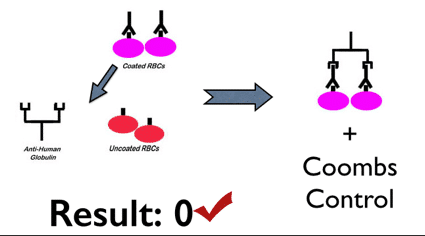Glossary
Check Cells
An unofficial term for the antibody-coated red cells used as to perform required quality control for negative indirect or direct antiglobulin tests performed in test tubes (the cells are more formally known as “Coombs Control” cells or even more properly as “IgG-coated RBCs”).
When an IAT or DAT is negative, the anti-human globulin (AHG) reagent is “floating around” free in the tube (since it did not find any antibody-coated RBCs with which to bind). In order to make sure that a) AHG was added, and b) the AHG is working, we add previously prepared, antibody-coated RBCs to the tube (left side of figure). The AHG should attach to the IgG-coated check cells and give visible agglutination after centrifugation (right side of figure). The antibody-coated RBCs typically are purchased from a blood bank reagent manufacturer (they are usually RhD-positive RBCs coated with anti-D).
Check cells get their name from the fact that when they are added and agglutination is seen as expected, laboratorians often indicate that fact by placing a “checkmark” next to the “0” that they wrote down for the negative reaction (you can see that below, with the “0” followed by the red checkmark). NOTE: To see how this looks in practice, go to the video page on this site and watch “Antibody ID, part 1” from 16:00 to 19:00 in the video).
Updated March 2023 by Joe Chaffin.


